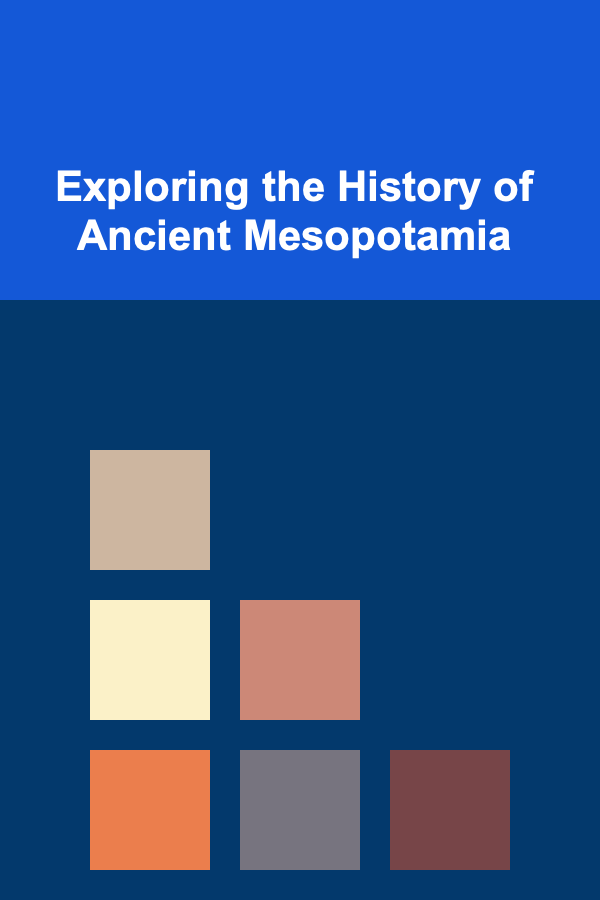
Exploring the History of Ancient Mesopotamia
ebook include PDF & Audio bundle (Micro Guide)
$12.99$10.99
Limited Time Offer! Order within the next:

Ancient Mesopotamia, the "land between the rivers" (Tigris and Euphrates), cradled some of humanity's earliest and most influential civilizations. From the dawn of agriculture to the development of writing, law, and complex social structures, Mesopotamia's legacy continues to resonate in the modern world. Exploring its history is a fascinating journey, requiring a multi-faceted approach encompassing archaeology, textual analysis, and a critical understanding of the challenges inherent in interpreting the past.
Understanding Mesopotamia's Geography and Chronology
Before delving into specific aspects of Mesopotamian history, it's crucial to establish a solid foundation regarding its geography and chronology. Mesopotamia, roughly corresponding to modern-day Iraq, parts of Syria, and southeastern Turkey, was not a unified political entity. Instead, it comprised a collection of city-states and empires that rose and fell over millennia. Understanding the geographical context is vital; the fertile plains, dependent on the unpredictable Tigris and Euphrates rivers, shaped agricultural practices, trade routes, and the nature of Mesopotamian society.
The chronological framework is complex, divided into periods often named after dominant cultures or significant political events. A simplified overview includes:
- The Ubaid Period (c. 6500-3800 BCE): Characterized by the development of settled agricultural communities and the emergence of proto-urban centers.
- The Uruk Period (c. 3800-3000 BCE): Marked by significant urban growth, the invention of writing (cuneiform), and the development of complex social hierarchies. Uruk was one of the largest and most influential cities of this era.
- The Early Dynastic Period (c. 3000-2350 BCE): An era of competing city-states, such as Ur, Kish, and Lagash, each ruled by a king and vying for regional dominance.
- The Akkadian Empire (c. 2350-2100 BCE): The first empire in Mesopotamia, established by Sargon of Akkad, unifying the region under a single ruler.
- The Ur III Period (c. 2100-2000 BCE): A period of renewed Sumerian power centered in the city of Ur, characterized by a highly centralized bureaucracy.
- The Old Babylonian Period (c. 2000-1600 BCE): Dominated by the Amorite dynasty of Babylon, known for the Code of Hammurabi, one of the earliest known legal codes.
- The Kassite Period (c. 1600-1155 BCE): A period of foreign rule by the Kassites, who integrated into Mesopotamian society while preserving their own cultural identity.
- The Middle Assyrian Period (c. 1365-1076 BCE): The rise of the Assyrian empire in northern Mesopotamia, expanding its influence through military conquest.
- The Neo-Assyrian Empire (c. 911-609 BCE): A period of unprecedented Assyrian power, characterized by military might, territorial expansion, and elaborate royal palaces.
- The Neo-Babylonian Empire (c. 626-539 BCE): A revival of Babylonian power under Nebuchadnezzar II, known for the construction of the Hanging Gardens of Babylon and the Ishtar Gate.
- The Achaemenid Persian Empire (c. 539-331 BCE): Mesopotamia became part of the vast Persian Empire, ruled by the Achaemenid dynasty.
- The Hellenistic Period (c. 331-141 BCE): Following the conquest of Alexander the Great, Mesopotamia came under Greek influence, marked by the spread of Hellenistic culture.
This chronology is not definitive and is subject to ongoing scholarly debate and refinement as new archaeological discoveries are made. It serves as a general guideline for understanding the sequence of events in Mesopotamian history.
Key Sources for Understanding Mesopotamian History
Our understanding of ancient Mesopotamia relies on several key sources, each with its own strengths and limitations:
Archaeological Excavations
Archaeological excavations have been instrumental in uncovering the physical remains of Mesopotamian civilization. Sites like Uruk, Ur, Nineveh, and Babylon have yielded invaluable artifacts, including monumental architecture, temples, palaces, houses, tombs, and a wealth of everyday objects. The careful excavation and analysis of these artifacts provide insights into Mesopotamian culture, technology, social organization, and religious beliefs.
The process of archaeological investigation is complex and requires meticulous documentation. Stratigraphy, the study of the layering of soil and artifacts, is essential for establishing a chronological sequence. Dating techniques, such as radiocarbon dating and dendrochronology, help to determine the age of artifacts and structures. Furthermore, the contextual analysis of artifacts -- understanding their relationship to other objects and the surrounding environment -- is crucial for interpreting their significance.
However, archaeological evidence is often incomplete and fragmentary. Many sites have been looted or destroyed by natural disasters or human activity. Moreover, the interpretation of archaeological finds can be subjective and influenced by the biases of the archaeologists. It is important to consider the research questions that guided the excavation and the theoretical frameworks used to interpret the data.
Cuneiform Texts
The invention of cuneiform writing in Mesopotamia revolutionized communication and record-keeping. Cuneiform, meaning "wedge-shaped," was written on clay tablets using a reed stylus. Hundreds of thousands of cuneiform tablets have been discovered, covering a vast range of topics, including administrative records, legal documents, literary works, religious texts, and royal inscriptions.
The decipherment of cuneiform in the 19th century was a major breakthrough in Mesopotamian studies. Scholars like Henry Rawlinson played a pivotal role in deciphering the Behistun Inscription, a trilingual inscription (Old Persian, Elamite, and Akkadian) that provided a key to understanding cuneiform. The ability to read cuneiform texts has opened up a wealth of information about Mesopotamian history, culture, and thought.
Cuneiform texts provide valuable insights into Mesopotamian political history. Royal inscriptions often recount the deeds of kings, their military campaigns, building projects, and religious dedications. These inscriptions offer a perspective on how Mesopotamian rulers wanted to be remembered. However, it is important to note that royal inscriptions are often biased and propagandistic, designed to legitimize the ruler's power and achievements.
Beyond political history, cuneiform texts reveal much about Mesopotamian society and daily life. Legal codes, such as the Code of Hammurabi, provide insights into Mesopotamian law, justice, and social norms. Administrative records, such as lists of goods and accounts, shed light on Mesopotamian economy and trade. Literary works, such as the Epic of Gilgamesh, offer glimpses into Mesopotamian mythology, religion, and worldview.
The study of cuneiform texts requires specialized knowledge of ancient languages, such as Sumerian and Akkadian, as well as an understanding of cuneiform script and Mesopotamian culture. The interpretation of cuneiform texts can be challenging, as the language is often ambiguous and the context is sometimes unclear. Moreover, many cuneiform tablets are fragmentary or damaged, making it difficult to reconstruct the original text.
Iconography and Art
Mesopotamian art, including sculpture, reliefs, and cylinder seals, provides another valuable source of information about Mesopotamian history and culture. These images often depict scenes from daily life, religious rituals, and mythological narratives. The study of Mesopotamian iconography can reveal insights into Mesopotamian beliefs, values, and social structures.
For example, cylinder seals, small cylindrical objects engraved with intricate designs, were used to mark property and authenticate documents. The designs on cylinder seals often depict scenes of deities, kings, and mythical creatures. These images can provide clues about Mesopotamian religious beliefs and social hierarchies.
Mesopotamian sculptures and reliefs often adorned temples and palaces. These images were designed to impress and intimidate viewers, showcasing the power and wealth of the rulers. The depictions of military victories, religious processions, and royal ceremonies provide valuable insights into Mesopotamian political and religious life.
The interpretation of Mesopotamian art requires an understanding of Mesopotamian symbolism and artistic conventions. Many images are symbolic and represent abstract concepts. For example, the depiction of a king with certain attributes, such as a horned crown or a scepter, signifies his authority and divine right to rule.
External Sources
While Mesopotamian sources are paramount, external sources from neighboring cultures can also provide valuable perspectives. Egyptian, Hittite, and Greek texts sometimes mention Mesopotamia, offering alternative accounts of historical events and cultural interactions. These external sources can help to corroborate or challenge the information gleaned from Mesopotamian sources.
For example, the Hebrew Bible contains several references to Mesopotamia, particularly in connection with the stories of the patriarchs and the Babylonian exile. While the Hebrew Bible is a religious text with its own agenda, it provides a valuable glimpse into the interactions between Mesopotamia and the ancient Israelites.
Greek historians, such as Herodotus and Xenophon, also wrote about Mesopotamia, providing descriptions of its geography, culture, and history. While these accounts are often based on hearsay and secondhand information, they can offer valuable insights into how Mesopotamia was perceived by outsiders.
Key Themes in Mesopotamian History
Exploring the history of ancient Mesopotamia reveals several key themes that shaped its development:
The Development of Urban Centers
Mesopotamia witnessed the world's first cities. The growth of urban centers like Uruk, Ur, and Babylon was a defining feature of Mesopotamian civilization. These cities served as centers of political power, economic activity, and religious worship. The development of urban centers led to the emergence of complex social hierarchies, specialized labor, and sophisticated forms of governance.
The construction of monumental architecture, such as temples and palaces, was a hallmark of Mesopotamian urban centers. These structures required a significant investment of resources and labor, reflecting the power and wealth of the ruling elite. The temples served as the focal point of religious life, while the palaces served as the administrative centers of the state.
The growth of urban centers also led to the development of sophisticated infrastructure, such as irrigation systems, canals, and roads. These systems were essential for supporting the growing population and facilitating trade. The management of these systems required a high degree of organization and coordination.
The Rise and Fall of Empires
Mesopotamian history is marked by the rise and fall of numerous empires, each vying for regional dominance. The Akkadian Empire, the Babylonian Empire, the Assyrian Empire, and the Neo-Babylonian Empire all left their mark on Mesopotamian history. The rise of empires was often driven by military conquest, economic expansion, and the desire for control over resources.
The empires of Mesopotamia were characterized by strong central governments, elaborate bureaucracies, and powerful armies. The rulers of these empires often claimed divine authority, using religion to legitimize their power. The empires also fostered trade and cultural exchange, spreading Mesopotamian ideas and technologies throughout the region.
The fall of empires was often due to internal conflicts, economic problems, and external threats. The empires of Mesopotamia were constantly challenged by rival powers and internal rebellions. The overextension of empires, coupled with economic instability, often led to their collapse.
The Development of Law and Governance
Mesopotamia made significant contributions to the development of law and governance. The Code of Hammurabi, one of the earliest known legal codes, provides insights into Mesopotamian legal principles and social norms. The Code of Hammurabi sought to establish justice and order in society, regulating various aspects of life, from property rights to family law.
Mesopotamian rulers developed sophisticated systems of governance, including bureaucracies, taxation, and legal procedures. The bureaucracy was responsible for managing the state's resources and administering justice. Taxation provided the revenue necessary to support the government and the army. Legal procedures ensured that disputes were resolved fairly and efficiently.
The concept of kingship played a central role in Mesopotamian governance. Mesopotamian kings were seen as intermediaries between the gods and the people. They were responsible for maintaining order, ensuring prosperity, and defending the state from its enemies. The kings often claimed divine authority, using religion to legitimize their rule.
Religion and Mythology
Religion permeated every aspect of Mesopotamian life. Mesopotamians believed in a pantheon of gods and goddesses who controlled the forces of nature and influenced human affairs. The gods were worshipped in temples, where priests performed rituals and offered sacrifices. Mesopotamian mythology provided explanations for the origins of the world, the nature of humanity, and the relationship between gods and humans.
The Epic of Gilgamesh, one of the oldest known works of literature, offers insights into Mesopotamian mythology and worldview. The Epic of Gilgamesh tells the story of a legendary king who embarks on a quest for immortality. The epic explores themes of mortality, friendship, and the limits of human ambition.
Mesopotamian religious beliefs influenced their art, architecture, and social customs. Temples were decorated with images of gods and goddesses, reflecting the importance of religion in Mesopotamian society. Religious festivals and ceremonies were an integral part of Mesopotamian life, providing opportunities for communal worship and social interaction.
Challenges in Interpreting Mesopotamian History
Despite the wealth of available sources, interpreting Mesopotamian history presents several challenges:
Fragmentary Evidence
Archaeological and textual evidence is often fragmentary and incomplete. Many sites have been looted or destroyed, and many cuneiform tablets are damaged or missing. This makes it difficult to reconstruct a complete and accurate picture of Mesopotamian history.
Bias and Perspective
The available sources are often biased and reflect the perspective of the ruling elite. Royal inscriptions, for example, are often propagandistic and designed to legitimize the ruler's power. It is important to be aware of these biases when interpreting Mesopotamian history.
Language and Translation
The study of cuneiform texts requires specialized knowledge of ancient languages and cuneiform script. The translation of cuneiform texts can be challenging, as the language is often ambiguous and the context is sometimes unclear. Moreover, different scholars may interpret the same text in different ways.
Modern Interpretations
Modern interpretations of Mesopotamian history are influenced by contemporary perspectives and values. Scholars may project their own biases and assumptions onto the past, leading to distorted or inaccurate interpretations. It is important to be aware of these potential biases when engaging with Mesopotamian history.
Resources for Further Exploration
If you are interested in further exploring the history of ancient Mesopotamia, here are some resources to consider:
- Museums: The British Museum, the Louvre Museum, the Metropolitan Museum of Art, and the Oriental Institute Museum (University of Chicago) all have extensive collections of Mesopotamian artifacts.
- Universities: Many universities offer courses and programs in Assyriology and Near Eastern Studies.
- Online Resources: The Electronic Text Corpus of Sumerian Literature (ETCSL) and the Cuneiform Digital Library Initiative (CDLI) offer access to digitized cuneiform texts and other resources.
- Books: Numerous books on Mesopotamian history and culture are available, ranging from introductory surveys to specialized studies. Some notable authors include Samuel Noah Kramer, Georges Roux, and Thorkild Jacobsen.
Conclusion
Exploring the history of ancient Mesopotamia is a rewarding but challenging endeavor. By engaging with archaeological evidence, cuneiform texts, iconography, and external sources, we can gain a deeper understanding of this fascinating civilization. While recognizing the limitations of our sources and the potential for bias, we can strive to reconstruct a more complete and nuanced picture of Mesopotamian history, appreciating its enduring legacy and its contribution to the development of human civilization. The "land between the rivers" continues to offer invaluable lessons about the complexities of human society, the power of innovation, and the enduring quest for meaning and purpose.

10 Budget-Friendly Alternatives for Personal Care Products You Need to Try
Read More
Creating Inclusive Communities: A Social Worker's Handbook
Read More
How To Manage Forest Fires for Wildlife Protection
Read More
How to Incorporate Traditional Chinese Medicine into Your Life
Read More
Reducing Demand for Illegal Wildlife Products: A Deep Dive
Read MoreHow to Use Your Period Tracker Planner for Fertility Awareness
Read MoreOther Products

10 Budget-Friendly Alternatives for Personal Care Products You Need to Try
Read More
Creating Inclusive Communities: A Social Worker's Handbook
Read More
How To Manage Forest Fires for Wildlife Protection
Read More
How to Incorporate Traditional Chinese Medicine into Your Life
Read More